How zapping sand with electricity could help stop coastal erosion

An artistic illustration of how electricity can strengthen the sand along ocean coastlines. The inset shows a microscopic image of a "natural cement" (in blue) formed among grains of sand
- Published
A zap of electricity could strengthen marine coastlines for generations, new research claims.
Coastal erosion is a big problem for communities across the world especially with rising sea levels.
Current solutions to the problem only last a few years and involve either building a sea wall or trucking in more sand.
But, in a new study, published in the journal Communications Earth & Environment, researchers have found an unusual solution.
They discovered that sending low voltage electricity through sand soaked with water, changed the structure of the marine sand transforming it into a rock-like, solid.
- Published27 February 2024
- Published8 March 2022
- Published9 April 2020
The team took inspiration from clams, mussels and other shell-dwelling sea life that use dissolved minerals in seawater to build their strong shells.
In laboratory experiments the electrical current would form the same minerals which could bind the sand together.
Alessandro Rotta Loria, from Northwestern University and one of the lead researchers, said: “After being treated, the sand looks like a rock.
“It is still and solid, instead of granular and incohesive. The minerals themselves are much stronger than concrete, so the resulting sand could become as strong and solid as a sea wall.”
Although minerals form instantly, longer applied electrical currents produced better results.
“We have noticed remarkable outcomes from just a few days of stimulations,” Rotta Loria said.
“Then, the treated sand should stay in place, without needing further interventions.”

These rock samples were created by a low voltage through the sand
Rotta Loria says the treated sand should keep its durability and protect coastlines for decades.
He also says the currents are safe for sea life with the voltages too mild to affect them.
Other researchers have used similar processes to strengthen undersea structures or even restore coral reefs without harming sea creatures.
The process is completely reversible so if a community no longer wants the solidified sand, the battery's anode and cathode electrodes can be switched and the electricity can dissolve the minerals.
Strength tests showed that the newly formed rock was about one-tenth as strong as concrete.
The researchers say the process could help strengthen sandy areas at the bases of cliffs and slow erosion down, or strengthen the foundations of houses built on the shore or even heal cracked structures made of reinforced concrete.
“The applications of this approach are countless,” Rotta Loria said. “There are many ways to apply this to protect coastal areas.”
